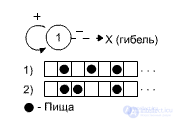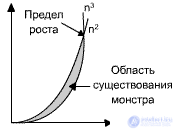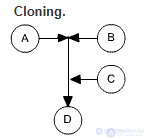Lecture
Reproduction - the function of ensuring the extension of the genus, their own kind. Moreover, the organism should improve the breed from generation to generation or change, at least, transmit, accumulate information. That is why nature has provided death, and not endless improvement of the organism - nature is trying to eliminate the transition to a dead end of an individual by endless development. Reproduction and improvement of adaptability is an essential function and must be in both living and artificial organisms. For example, the repetition of their own kind in geometry is a fractal.
Take an infinite environment of cells - a cyclic matrix (the field is a torus). There are automata on this field. Some cells have food that can be restored after a certain time. At the beginning of evolution, there were 4 types of automata {A, B, C, D}. Scheme of the automaton A {1,1} in Figure 8.1. The machine can only move in one direction (D = 1). On the first tape, he can move endlessly. But it is only slightly change the conditions (tape 2) and the machine is killed. Such a device is not adapted to a non-stationary environment.

If automata fall into one cell, they are combined into one. If automata of the same type occur, the petal depth increases. If different - the number of petals increases. This process is called polymerization. As a result of several meetings, the following {A 2 GW} structure may arise:

The result is a structure that is more adapted to life in a complex environment. The elements, when combined, receive new qualitative properties, which none of the parts of this association have.


The cloning scheme is presented in Figure 8.4. A is a genetic mother, they take a cell from her that has a full set of chromosomes. Moreover, this cell must be optional sexual. B - the mother who gave the egg. All chromosomes are removed from this egg cell. The cell of the genetic mother is reunited with the mother B egg. The reunion takes place outside the body, using, for example, an electric charge. The surrogate mother (C) grows the fruit. As a result, we get an animal D - clone, with a complete genetic set of object A.
Sexual.
Option reproduction and evolution. Reproduction is achieved by mixing sets of chromosomes through mating, evolution by selecting the resulting organisms. Mutations are also possible (change of signs is random or under the influence of external factors).
In inanimate nature, the crystal, fractal, has repeatability.
Orkornoviruses - the border of living and nonliving. No DNA. They can not reproduce themselves independently, multiply in a foreign body. They penetrate into a bacterium or a living cell, merge with DNA, providing their own reproduction.
Bacteria are living matter. The bacterium has DNA, but the length of its DNA is small - all elements are occupied. There is no opportunity to develop, as there is no variability. Compare: the length in the stretched form of the DNA of the virus is 0.1 mm, the microbe is 1.5 mm, the Drosophilus is 61 mm. Information capacity in relation to used and potential options.
Highly organized living matter - “works” only 1% of DNA. The number of possible mutations is huge. Organisms develop, evolve. 1% of DNA gives 5 * 1010 different proteins. The choice (mutation) is made from the existing protein, but not in general.
But evolutionary theory has questions. Does evolution really move us? There are structures that cannot evolve. In the course of history, many revolutionary leaps have occurred that are difficult to explain.
The goal of evolution is in the accumulation of structural energy, and in more and more complex structural forms. There is a continuous struggle for efficiency. Efficiency allows you to develop. Highly organized forms are used to increase the efficiency of even someone else's potential (a person eats not grass but meat, uses plants, oil for energy, amplifiers of space, speed, physical and mental efforts - a lever, wheel, telephone, computer). All these are stages of evolution.
The purpose of life - the reproduction of their own kind, the continuation of the species to infinity.
The purpose of nature is an increasingly active process of energy transformation of the Earth’s matter.
In computer technology, prototypes of the CAM process are computer viruses, Stratum technology, von Neumann machine.
In Stratum, you can assemble a model that provides self-reproduction, reproduction, mutations in descendants and evolution. So start a process of self-improvement.
Initially, there is a root schema. This is a field, a space for evolution. Create manually some Parent object. Its property is written in the string x: = x + 1 .
Create a demiurge. Its properties are that it creates the child1 class following the parent pattern, and then creates object 00 as an instance of the child1 class in the root schema. The instance is set to x, y .
R: = CreateClass ('child1', 'parent', 0)
H: = CreateObject ('root', 'child1', '00', x, y)
Thus, the demiurge on the evolutionary field per clock will create a copy of the Parent object with the property x: = x + 1 . If you take care of changing the strings '00' and 'child1', for example, by accident or by a counter, then at the next measure new copies of the Parent object will be created with different names ( 01 , 02 , 03 , :), but with the same properties x: = x +1
If you use the standard ChangeModel object, you can change (or insert) i the string to a new context, which can be chosen randomly from the list or generated as a random string. For example, replacing x: = x + 1 with x: = x + 2 gives a replacement for an object property. Finally, you can mix the texts of various objects by creating a new object with inheriting the properties of the ancestors.
Comments
To leave a comment
Artificial Intelligence
Terms: Artificial Intelligence